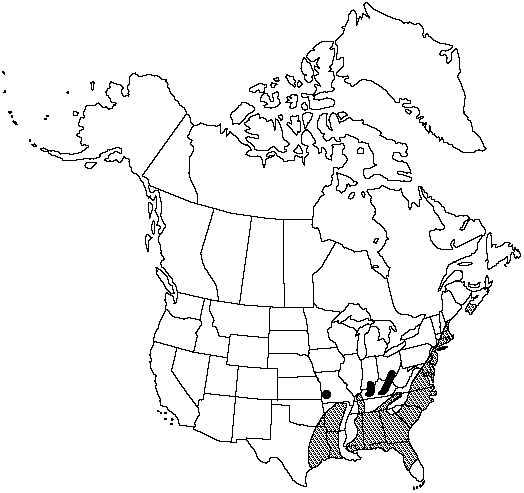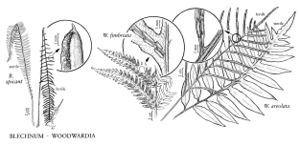Woodwardia areolata
Index Fil. 45. 1857.
Stems long-creeping, slender; scales brown, many, broadly lanceolate. Leaves dimorphic, deciduous, few, well separated; sterile leaves 40-58 cm, fertile leaves 49-70 cm. Petiole reddish-brown proximally, straw-colored distally; base not swollen, with sparsely set brown scales. Blade bright green, generally lanceolate, scaly-glandular upon emergence but soon glabrate; sterile leaves pinnatifid, 13-26 cm; fertile leaves pinnate, sharply contracted, 20-27 cm. Pinnae not articulate to rachis, arranged in 7-12 alternate pairs; sterile pinnae lanceolate, 3-11 × 1-2.5 cm; fertile pinnae contracted, linear, 3-11 × 0.2-0.5 cm. Veins anastomosing into 2 or more rows of areoles between costae and margin, free only at blade margin. Sori linear-oblong, deeply sunken into blades, nearly occupying full breadth of blade. Indusia ± membranous, lacking thickened cells, tucked under sporangia, not recurving but mostly disintegrating with age. 2n = 70.
Habitat: Acidic bogs, seeps, and wet woods, rarely on rock of siliceous cliffs and ledges on northern edge of range
Elevation: 0-600 m
Distribution

N.S., Ala., Ark., Conn., Del., Fla., Ga., Ill., Ind., Ky., La., Maine, Md., Mass., Miss., Mo., N.H., N.J., N.Y., N.C., Ohio, Okla., Pa., R.I., S.C., Tenn., Tex., Va., W.Va.
Discussion
Woodwardia areolata is most abundant on the coastal plain of the eastern United States, scattered in the Ouachita and Boston mountains, Ozark and Cumberland plateaus, and the Piedmont, but not in the high Appalachians, the heavy gumbo soils of the Mississippi Valley, or the limestone regions of the Interior Low Plateaus. It apparently has been extirpated in Maine where it is known only from specimens collected in the 1860s.
Features such as extreme leaf dimorphism, sunken sori, and expanded persistent indusia set Woodwardia areolata apart from all others in the genus. The existence of closely related transitional species in Asia, however, makes generic segregation uncertain. Those who wish to recognize a monotypic generic segregate based on Woodwardia areolata must coin a new name because Lorinseria C. Presl (1849) is an orthographic variant of Lorinsera Opiz (1839). For a detailed discussion of the ecology and geography of this species, see R. Cranfill (1983). Sterile specimens of this species are sometimes confused with Onoclea sensibilis.
Selected References
None.
